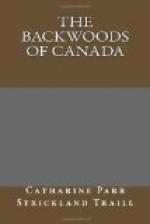They have a peculiarly melancholy call-note at times, which sounds exactly like the sudden twang of a harp-string, vibrating for a second or two on the ear. This, I am inclined to think, they use to collect their distant comrades, as I have never observed it when they were all in full assembly, but when a few were sitting in some tree near the lake’s edge. I have called them the “harpers” from this peculiar note. I shall tire you with my ornithological sketches, but must enumerate two or three more birds.
The bald eagle frequently flies over our clearing; it has a dark body, and snow-white head. It is sometimes troublesome to the poultry-yards: those we have seen have disdained such low game, and soared majestically away across the lake.
The fish-hawk we occasionally see skimming the surface of the water, and it is regarded as an enemy by those who take delight in spearing fish upon the lakes.
Then we have the night or mosquito-hawk, which may be seen in the air pursuing the insect tribe in the higher regions, whilst hundreds of great dragonflies pursue them below; notwithstanding their assistance, we are bitten mercilessly by those summer pests the mosquitoes and black flies.
The red-headed woodpecker is very splendid; the head and neck being of a rich crimson; the back, wings, and breast are divided between the most snowy white and jetty black. The incessant tapping of the woodpeckers, and the discordant shriek of the blue jay, are heard from sunrise to sunset, as soon as the spring is fairly set in.
I found a little family of woodpeckers last spring comfortably nested in an old pine, between the bark and the trunk of the tree, where the former had started away, and left a hollow space, in which the old birds had built a soft but careless sort of nest; the little creatures seemed very happy, poking their funny bare heads out to greet the old ones, who were knocking away at the old stumps in their neighbourhood to supply their cravings, as busy as so many carpenters at work.
[Illustration: Baltimore Oriole defending her Nest against the Black Snake.]
A very curious bird’s-nest was given me by one of our choppers; it was woven over a forked spray, so that it had all the appearance of having been sewn to the bough with grey thread. The nest was only secured at the two sides that formed the angle, but so strong was it fastened that it seemed to resist any weight or pressure of a moderate kind; it was composed of the fibres of the bass-wood bark; which are very thready, and may be drawn to great fineness: on the whole it was a curious specimen of the ingenuity of these admirable little architects. I could not discover the builder; but rather suspect the nest to have belonged to my protege, the little winter titmouse that I told you of.
The nest of the Canadian robin, which I discovered while seeking for a hen’s nest in a bush-heap, just at the further edge of the clearing, is very much like our home-robin’s, allowing something for difference of size in the bird, and in the material; the eggs, five in number, were deep blue.




